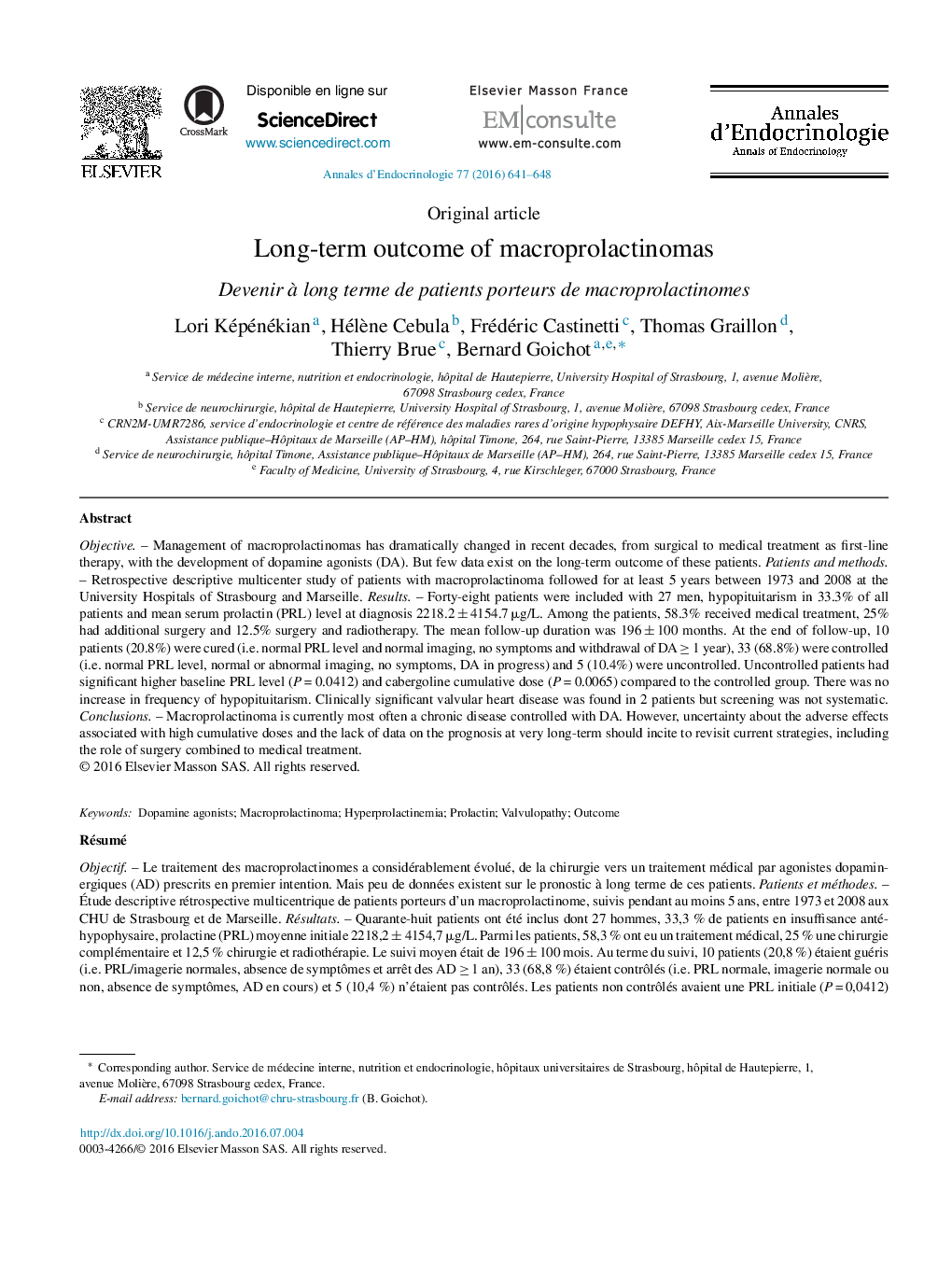| کد مقاله | کد نشریه | سال انتشار | مقاله انگلیسی | نسخه تمام متن |
|---|---|---|---|---|
| 5654359 | 1407272 | 2016 | 8 صفحه PDF | دانلود رایگان |
ObjectiveManagement of macroprolactinomas has dramatically changed in recent decades, from surgical to medical treatment as first-line therapy, with the development of dopamine agonists (DA). But few data exist on the long-term outcome of these patients.Patients and methodsRetrospective descriptive multicenter study of patients with macroprolactinoma followed for at least 5 years between 1973 and 2008 at the University Hospitals of Strasbourg and Marseille.ResultsForty-eight patients were included with 27 men, hypopituitarism in 33.3% of all patients and mean serum prolactin (PRL) level at diagnosis 2218.2 ± 4154.7 μg/L. Among the patients, 58.3% received medical treatment, 25% had additional surgery and 12.5% surgery and radiotherapy. The mean follow-up duration was 196 ± 100 months. At the end of follow-up, 10 patients (20.8%) were cured (i.e. normal PRL level and normal imaging, no symptoms and withdrawal of DA â¥Â 1 year), 33 (68.8%) were controlled (i.e. normal PRL level, normal or abnormal imaging, no symptoms, DA in progress) and 5 (10.4%) were uncontrolled. Uncontrolled patients had significant higher baseline PRL level (P = 0.0412) and cabergoline cumulative dose (P = 0.0065) compared to the controlled group. There was no increase in frequency of hypopituitarism. Clinically significant valvular heart disease was found in 2 patients but screening was not systematic.ConclusionsMacroprolactinoma is currently most often a chronic disease controlled with DA. However, uncertainty about the adverse effects associated with high cumulative doses and the lack of data on the prognosis at very long-term should incite to revisit current strategies, including the role of surgery combined to medical treatment.
RésuméObjectifLe traitement des macroprolactinomes a considérablement évolué, de la chirurgie vers un traitement médical par agonistes dopaminergiques (AD) prescrits en premier intention. Mais peu de données existent sur le pronostic à long terme de ces patients.Patients et méthodesÃtude descriptive rétrospective multicentrique de patients porteurs d'un macroprolactinome, suivis pendant au moins 5 ans, entre 1973 et 2008 aux CHU de Strasbourg et de Marseille.RésultatsQuarante-huit patients ont été inclus dont 27 hommes, 33,3 % de patients en insuffisance anté-hypophysaire, prolactine (PRL) moyenne initiale 2218,2 ± 4154,7 μg/L. Parmi les patients, 58,3 % ont eu un traitement médical, 25 % une chirurgie complémentaire et 12,5 % chirurgie et radiothérapie. Le suivi moyen était de 196 ± 100 mois. Au terme du suivi, 10 patients (20,8 %) étaient guéris (i.e. PRL/imagerie normales, absence de symptômes et arrêt des AD â¥Â 1 an), 33 (68,8 %) étaient contrôlés (i.e. PRL normale, imagerie normale ou non, absence de symptômes, AD en cours) et 5 (10,4 %) n'étaient pas contrôlés. Les patients non contrôlés avaient une PRL initiale (P = 0,0412) et une dose cumulée de cabergoline (P = 0,0065) plus élevées que les patients contrôlés. Le taux d'hypopituitarisme n'était pas augmenté. Deux valvulopathies significatives étaient retrouvées mais la recherche n'a pas été systématique.DiscussionLe macroprolactinome doit être considéré comme une maladie chronique contrôlée par les AD. Mais les incertitudes sur les effets indésirables liés à de fortes doses cumulées et le manque de données sur le pronostic à très long terme devraient faire rediscuter des stratégies actuelles, notamment de la place de la chirurgie combinée au traitement médical.
Journal: Annales d'Endocrinologie - Volume 77, Issue 6, December 2016, Pages 641-648
